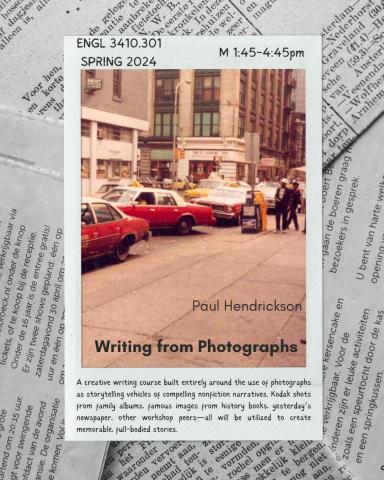A creative writing course built entirely around the use of photographs, and the crafting of compelling nonfiction narratives from them. The essential concept will be to employ photographs as storytelling vehicles. So we will be using curling, drugstore-printed Kodak shots from our own family albums. We will be using searing and famous images from history books. We will be taking things from yesterday’s newspaper. We will even be using pictures that were just made by the workshop participants outside the campus gates with a disposable camera from CVS or with their own sophisticated digital Nikon. In all of this, there will be one overriding aim: to achieve memorable, full-bodied stories. To locate the strange, evocative, storytelling universes that are sealed inside the four rectangular walls of a photograph. They are always there, if you know how to look. It’s about the quality of your noticing, the intensity of your seeing.
Writers as diverse as the poet Mark Strand and the novelist Don DeLillo and the memoirist Wright Morris have long recognized the power of a photograph to launch a story. In this course we are going to employ memory and imagination to launch our stories, but most of all we are going to make use of fact: everything that can be found out, gleaned, uncovered, dug up, stumbled upon. Because first and last, this is nonfiction, this is the art of reported fact. So a lot of this class will go forward using the tools and techniques of journalism: good, old-fashioned reporting and research, legwork. And turning that reporting into writing gold. A photograph represents time stopped in a box. It is a kind of freeze-frame of eternity. It is stopped motion, in which the clock has seemed to hold its breath. Often, the stories inside photographs turn out to be at surprising odds with what we otherwise thought, felt, imagined.
Say, for instance, that you hunger to enter the photographic heart of this youthful, handsome, dark-haired man—who is your father—as he leans now against the gleaming bumper of a 1965 red-leather, bucket-seat Mustang. It was three decades before you were born. The moment is long buried and forgotten in your collective family’s past—and yet in another way, it is right here before you, on this photosensitive surface. Whether the figure in the photograph is alive or deceased, you are now going to try with all of your writing and reporting might to “walk back in.” Almost literally. You are going to achieve a story about this moment, with a beginning, middle, and end.
“Every great photograph has a secret,” a noted critic once said. An essayist for Time magazine once wrote: “All great photographs have lives of their own. But sometimes they can be false as dreams.”
Syllabus:
This is a creative writing workshop built entirely around the use of photographs, and the crafting of compelling nonfiction narratives from them. The essential concept will be to employ photographs—family photographs, iconic photographs, photographs from yesterday’s New York Times—as storytelling vehicles. Our goal is to achieve memorable, full- bodied accounts. To locate the strange, evocative, storytelling universes sealed inside the four rectangular walls of a photograph. The stories are always there, if you know how to look, if you know how to go about asking the questions (say, of your parents), if you are willing to put in the sweat of research time. Never mind the greater sweat of the writing time.
It is a workshop, which suggests and implies participatory group labor. We’ll have to compassionately depend on each other. The class will go forward each week on: 1) readings from masterful writers which we will discuss in class as models of the form; and 2) your own work, presented to your peers, followed by their constructive criticism.
The aim is for each writer to get a minimum of two full presentations of her/his/their work. You will be asked to do four pieces of writing for credit, each one a little longer and harder than the last. (We will begin with a little no-count-for-credit and just-for-fun tune-up.) I will have uploaded on Canvas all the readings and other materials to spare you any purchasing burdens. The following week’s reading will be announced at the end of a particular class. By the third week of the term, we will be presenting our own serious work, and then we will truly (and excitedly) turn into a “workshop.”
We will come together once a week, but in between I will be available for individual consultations. Attendance at each class is compulsory. The entire course goes forward on what we learned the preceding week: It is cumulative. To miss a class, except in understandable and serious circumstances (illness that cannot be fooled with, or some other unexpected event) is to miss the cumulative build.
What I want most is for us to have a good time, while we get our creative juices collectively and individually flowing.
Syllabus and a fuller course description will follow this prospectus before the end of the year.
Thank you.
Professor Paul Hendrickson

 Department of English
Department of English
